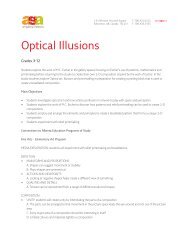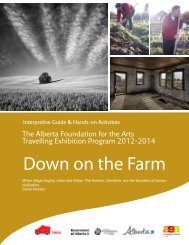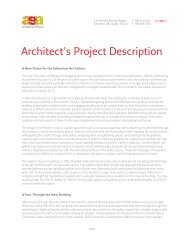A Bird in the Hand - Art Gallery of Alberta
A Bird in the Hand - Art Gallery of Alberta
A Bird in the Hand - Art Gallery of Alberta
- No tags were found...
You also want an ePaper? Increase the reach of your titles
YUMPU automatically turns print PDFs into web optimized ePapers that Google loves.
The <strong>Alberta</strong> Foundation for <strong>the</strong> <strong>Art</strong>s Travell<strong>in</strong>g Exhibition ProgramElements <strong>of</strong> Composition–How would you describe <strong>the</strong> colour <strong>of</strong> each object? What objects are lightest? darkest?Where are <strong>the</strong>y located with<strong>in</strong> <strong>the</strong> pa<strong>in</strong>t<strong>in</strong>g? Foreground? Midground? Background?–Where are <strong>the</strong> warm colours located with<strong>in</strong> <strong>the</strong> pa<strong>in</strong>t<strong>in</strong>g? Where are <strong>the</strong> cool colours?–Describe <strong>the</strong> use <strong>of</strong> complementary colour with<strong>in</strong> <strong>the</strong> artwork. How does this use createfocus or direct <strong>the</strong> viewer’s eye towards certa<strong>in</strong> areas or objects?The use <strong>of</strong> red/green complementary colour directs <strong>the</strong> viewer’s attention towards<strong>the</strong> objects <strong>in</strong> <strong>the</strong> foreground and creates space and <strong>in</strong>tensity. The use <strong>of</strong> brightcomplementaries <strong>in</strong> <strong>the</strong> background creates a balance between background andforeground.*Be as descriptive/use as many descriptive words as possible.–How does <strong>the</strong> colour <strong>of</strong> <strong>the</strong> pa<strong>in</strong>t<strong>in</strong>g make you feel? The colours are bright and cheerful.–What narrative/story could you put to this image?D) TEXTURE: SEE Cock and Hen by Maxwell BatesQuestions to Guide Inquiry:–What does <strong>the</strong> term texture mean? - Texture can be actual, simulated or <strong>in</strong>vented.–What do you see <strong>in</strong> this work? - a cock and a hen <strong>in</strong> a natural sett<strong>in</strong>g.–How has texture been created <strong>in</strong> this work? - The textures are simulated. The pr<strong>in</strong>tmak<strong>in</strong>gtechnique that is used is important to create <strong>the</strong> mark-mak<strong>in</strong>g that results<strong>in</strong> scratchy, irregular l<strong>in</strong>es. The surface quality <strong>of</strong> <strong>the</strong> pr<strong>in</strong>t portrays <strong>the</strong> grasses andlandscape <strong>the</strong> birds are <strong>in</strong>. The variety <strong>of</strong> l<strong>in</strong>es presented <strong>in</strong>dicate a change <strong>in</strong> texturalquality from <strong>the</strong> grasses to <strong>the</strong> implied textural surface <strong>of</strong> <strong>the</strong> birds.–What is <strong>the</strong> mood created <strong>in</strong> this work, how does it make you feel? - sombre, happy etcbecause...The pr<strong>in</strong>t presents a harsh, rugged feel<strong>in</strong>g that expresses some discomfort to<strong>the</strong> landscape <strong>the</strong>se birds are <strong>in</strong>.E) SPACE: SEE Untitled, Illustration from “A Man called Raven” by George LittlechildQuestions to Guide Inquiry:–How would you describe <strong>the</strong> space <strong>in</strong> this work? Is <strong>the</strong>re an obvious foreground,midground and background?–Where are <strong>the</strong> objects located with<strong>in</strong> <strong>the</strong> space? What makes you th<strong>in</strong>k this? -based on<strong>the</strong> size <strong>of</strong> <strong>the</strong> objects, overlapp<strong>in</strong>g, and <strong>the</strong> use <strong>of</strong> warm and cool colours, some objectsappear closer than o<strong>the</strong>rs. For example, based on <strong>the</strong> size <strong>of</strong> <strong>the</strong> moose, it is fur<strong>the</strong>raway <strong>in</strong> <strong>the</strong> picture than <strong>the</strong> fish who appears much larger. The warm colours <strong>of</strong> <strong>the</strong> fishalso br<strong>in</strong>g it closer to <strong>the</strong> foreground.–How has <strong>the</strong> artist divided up <strong>the</strong> pa<strong>in</strong>t<strong>in</strong>g? The pa<strong>in</strong>t<strong>in</strong>g is divided <strong>in</strong>to three verticalparts. Why has <strong>the</strong> artist done this? Possibly to show different areas <strong>in</strong> nature, i.e. land,sky and water. The warm p<strong>in</strong>ks and reds <strong>in</strong> each section as well as <strong>the</strong> similar markmak<strong>in</strong>gallow <strong>the</strong> viewer’s eye to travel across each vertical that separates <strong>the</strong> pa<strong>in</strong>t<strong>in</strong>g.–What are possible narratives with<strong>in</strong> <strong>the</strong> work?AFA Travell<strong>in</strong>g Exhibition Program, Edmonton, AB Ph: 780.428.3830 Fax: 780.421.0479youraga.ca
















